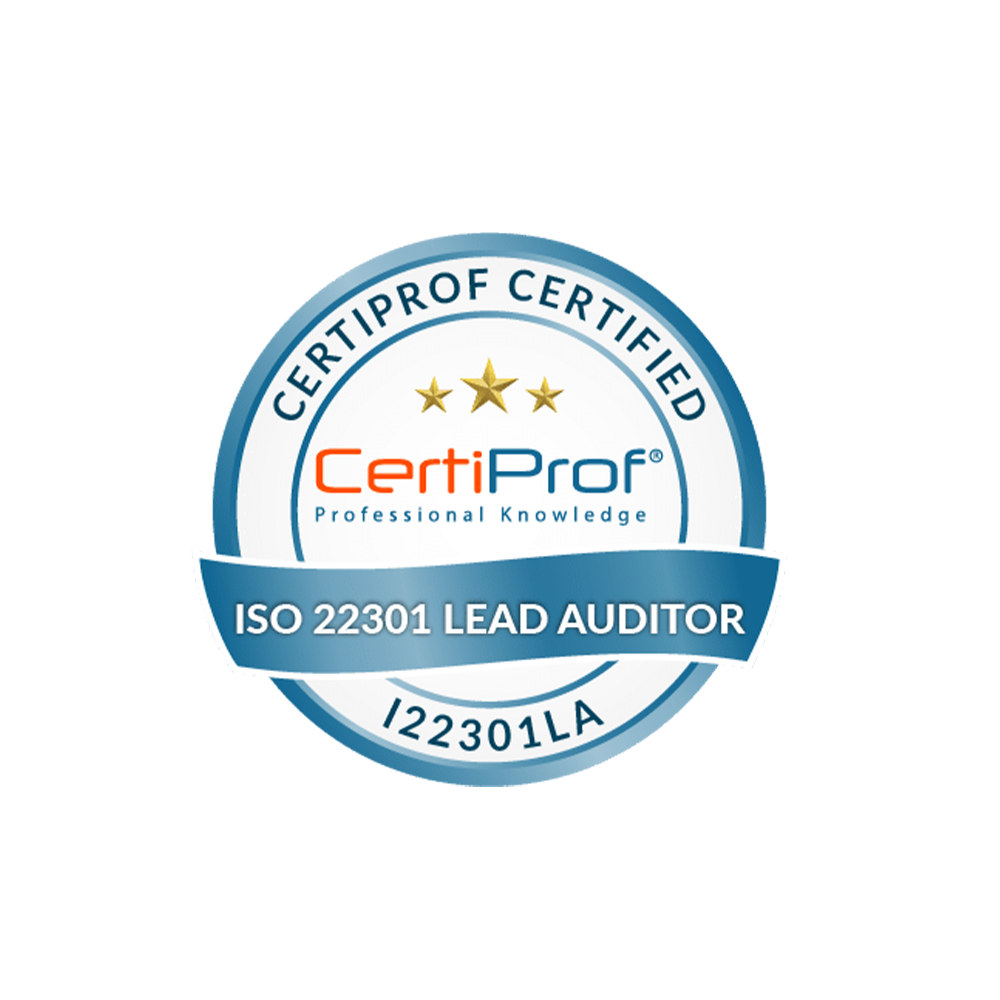-
Registered Students:
42
-
Duration:
--
-
Sections:
12
-
Difficulty Level:
Intermediate
- DESCRIPTION
- CURRICULUM
- FAQ
- ANNOUNCEMENT
This certification is about business continuity and the requirements of ISO 22301 – the most popular standard in the world that addresses the topic of business continuity.
The outline follows the structure of ISO 22301 standard covering the following requirements: Context of the organization, leadership, planning, support, operation, performance evaluation and improvement. The continuity of the business is not limited to the information systems, it goes further, taking into account the integrity of the people who work in the company, since they feed the information systems and therefore the main asset.
Learning Objectives
– Comprehend the principles, concepts and requirements of ISO 22301:2012.
– Identify how to develop a BCMS.
– Develop skills and ability to conduct audits.
Audience Profile
– Those who need to know what ISO 22301 is all about and how to execute and report an audit compliance with ISO 22301:2012.
The course work involves lectures, discussions, role-play, individual and group exercises to get you started with understanding the ISO 22301 standard. After passing the ISO 22301 Auditor exam, you will have the knowledge required to perform effective BCMS audits.


Exam Details
To get the Lead Auditor Certificate a complimentary exam with an open book must be done, supervised by the partner, designed to allow students to demonstrate their comprehension of the audit process and the responsibilities of being a lead auditor.
ISO 27001/20000/22301 Lead Auditor is a written exam and must be proctored, therefore it is not available to the public, this exam must be carried out through our partner network. Please write to us at info@certiprof.org to process your request.
Certification Details
– Certification Type: Auditor
– Certification Code: I22301LA
Prerequisites
No specific prior knowledge required.
Familiarity with management systems is helpful.
General knowledge on business continuity and disaster recovery is helpful.
-
1. Introduction and Background
Introduction
BCMS Benefits
Standard History
Main Changes Applied to the 22301 Standard -
2. Terms and Definitions (See Annex)
-
3. Standard Structure
ISO 22301 Structure
Introduction
ISO 22301 Structure
PDCA and BCMS Cycle
ISO 22301 Structure -
4. Context of the Organization
4.1 Understanding the Organization and its Context
4.2 Understanding the Needs and Expectations of Interested Parties
Requirements for Workshop 4.1 and 4.2
4.3 Determining the Scope of the BCMS
4.4 Business Continuity Management System -
5. Leadership
Leadership
5.1 Leadership and Commitment
5.2 Policy
5.3 Roles, Responsibilities and Authorities -
6. Planning
Planning
6.1 Addressing Risks and Opportunities
6.2 Business Continuity Objectives and Planning to Achieve Them
6.3 Planning Changes to the BCMS -
7. Support
Support
7.1 Resources
7.2 Competence
7.3 Awareness
7.4 Communication
7.5 Documented Information -
8. Operation
Operation
8.1 Control and Operational Planning
8.2 Business Impact Analysis and Risk Assessment
Workshop 2: Business Impact Analysis (BIA)
8.2 Business Impact Analysis and Risk Assessment
8.3 Business Continuity Strategies and Solutions
8.4 Business Continuity Plans and Procedures
8.5 Exercise Program
8.6 Evaluation of Business Continuity Documentation and Capabilities -
9. Performance Evaluation
Performance Evaluation
9.1 Monitoring, Measurement, Analysis and Evaluation
9.2 Internal Audit
9.3 Management Review -
10. Improvement
Improvement
10.1 Non-conformity and Corrective Action
10.2 Continual Improvement -
Annex 1: Terms and Definitions
3.1 Activity
3.2 Audit
3.3 Business Continuity
3.4 Business Continuity Plan
3.5 Business Impact Analysis
3.6 Competence
3.7 Conformity
3.8 Continual Improvement
3.9 Corrective Action
3.10 Disruptive Incident
3.11 Documented Information
3.12 Effectiveness
3.13 Impact
3.14 Incident
3.15 Interested Parties
3.16 Management System
3.17 Measurement
3.18 Monitoring
3.19 Non-conformity
3.20 Objective
3.21 Organization
3.22 Outsource
3.23 Performance
3.24 Policy
3.25 Prioritized Activity
3.26 Process
3.27 Products and Services
3.28 Requirement
3.29 Resources
3.30 Risk
3.31 Top Management
-
11. ISO 19011: Auditing Module
ISO 19011:2018
ISO 19011:2018 Structure
ISO 19011:2018 Scope
Audit
Types of Audits
Audit Criteria
Audit Evidence
Audit Findings
Audit Conclusions
Audit Client
Auditee
Auditor
Audit Team
Technical Expert
Observer
Guide
Audit Program
Audit Scope
Planning the Audit
Conformity
Non-conformity
Audit Evidence
Audit Methods
Clause 4: Principles of Auditing
Clause 5: Audit Program
Clause 6: Audit Activities
Clause 7: Competence and Evaluation of Auditors
Methods to Evaluate Auditors
Clause 7: Personal Qualities
Clause 7: General Knowledge and Skills
Establishing Audit Program Objectives
Determining and Evaluating Audit Program Risks and Opportunities
Establishing the Audit Program
Competence of the Individual(s) Managing the Audit Program
Establishing Extent of the Audit Program
Determining Audit Program Resources
Implementing the Audit Program
Definition of Objectives, Scope and Criteria for an Individual Audit
Selecting and Determining Audit Methods
Selecting Audit Team Members
Assigning Responsibility for an Individual Audit to the Audit Team Leader
Managing Audit Program Results
Managing and Maintaining Audit Program Records
Reviewing and Improving Audit Program
Establishing Contact With The Auditee
Determining Feasibility of Audit
Review of Documented Information
Audit Planning
Preparing Audit Planning
Workshop 3: Developing the Audit Planning
Workshop 4: Audit Planning Matrix
Assigning Work to the Audit Team
Assigning Roles and Responsibilities for Guides and Observers
Preparing Documented Information for Audit
Possible Advantages of Checklists
Using Checklists
Workshop 5: Making a Checklist for Auditing Clauses that were requested by the Instructor
Opening Meeting
Reviewing Documented Information while Conducting an Audit
Communicating During the Audit
Collecting Information Methods
Methods of Collecting Information
Interview
Key Questions for the Auditor
Types of Questions
Conducting an Audit
Conducting Interviews
How to hinder (obstruct) an Audit (Auditee)?
Time Management
Handling Difficult Situations
Audit Findings
Types of Findings
Most Common Non-Compliances
Writing Non-Conformities
Formula for Writing a Non-Conformity
Audit Conclusions
Audit Report
Closing Meeting
Preparing and Distributing the Audit Report
Conducting an Audit Follow-up
Workshop 6: Per Format, Conducting Audit Report
The course is self paced. This means that you can learn at your own time and schedule, while completing the program you receive both the attendance certificate and certification through online exams.
The Seminar Tuition fee is € 150 and you can pay through PayPal, Credit/Debit card or Bank deposit.


Who is CertiProf®?
CertiProf® is an Examination Institute founded in 2015, in the USA. Located in Sunrise, Florida.
Our philosophy is based on community knowledge, and for that purpose its collaborative network is
made up of:
• CKA’s (CertiProf Knowledge Ambassadors), are influential people in their fields of expertise or
mastery, coaches, trainers, consultants, bloggers, community builders, organizers and evangelists,
who are willing to contribute in the improvement of content
• CLL’s (CertiProf Lifelong Learners), Certification candidates are identified as Continuing Learner
proven their unwavering commitment to lifelong learning, which is vitally important in today’s
ever-changing and expanding digitalized world. Regardless of whether they win or fail the exam
• ATP’s (Accredited Trainer Partners), Universities, training centers and facilitators around the
world that make up the partner network
• Authors (co-creators), Industry experts or practitioners who, with their knowledge, develop
content for the creation of new certifications that respond to the needs of the industry
• Internal Staff, our distributed team with operations in India, Brazil, Colombia and the United
States that support day by day the execution of the purpose of CertiProf®
